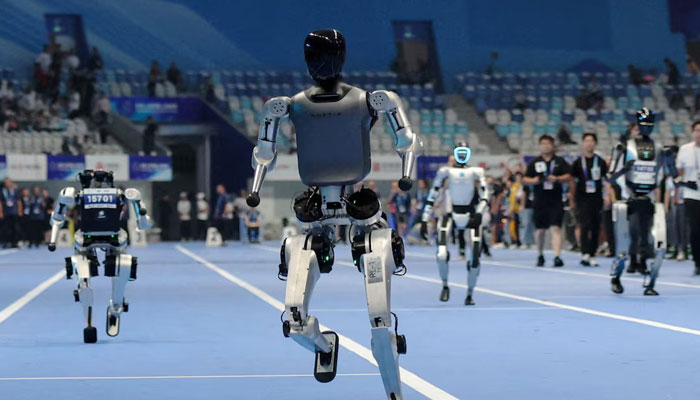China has once again placed itself at the center of global technological innovation by hosting the world’s first large-scale Robotic Olympics, a groundbreaking event that redefines the traditional meaning of sport and competition. The spectacle, held in Beijing, gathered teams of engineers, scientists, and students from more than 40 countries, all showcasing their robotic creations in a series of contests designed to test intelligence, speed, dexterity, and endurance.
The opening ceremony combined the grandeur of a conventional sports festival with futuristic elements. Instead of athletes marching into a stadium, robots rolled, walked, and even flew across the arena, proudly displaying the flags of their home nations. The display set the tone for what many are calling a historic moment not just for robotics but also for global cooperation in science and technology.
The competitions were divided into multiple categories, each reflecting a real-world challenge that robots may one day take on in human society. One of the most watched events was the “Rescue Challenge,” where robots navigated simulated disaster zones filled with rubble, smoke, and obstacles to find and retrieve survivors. The performance of these machines, some equipped with thermal imaging and artificial intelligence decision-making, impressed spectators who could immediately visualize their application in earthquake or flood-hit regions.
Another highlight was the “Industrial Relay,” a competition designed to test precision and efficiency in assembling complex objects under time pressure. Robots from Germany, Japan, and South Korea dominated this category, reflecting their countries’ strong traditions in manufacturing and automation. Audiences marveled at the speed with which robotic arms pieced together components with an accuracy no human hand could match.
The entertainment value of the Robotic Olympics was not lost either. Events like robotic soccer, sumo wrestling, and synchronized dancing captivated younger spectators and added a sense of playfulness to the otherwise highly technical competitions. In the soccer arena, humanoid robots, some only half the size of humans, dribbled and shot with surprising skill. Cheers erupted when a Chinese-built striker scored a last-minute goal against a Brazilian opponent, drawing parallels to the passion of the FIFA World Cup.
The competition also served as a platform for academic exchange. Universities and research institutes used the event to showcase advancements in machine learning, autonomous navigation, and human-robot interaction. Students from lesser-known institutions found themselves competing shoulder to shoulder with leading laboratories, gaining exposure and recognition that would have been unthinkable in a traditional academic conference. For many, the event was as much about building networks and sharing ideas as it was about winning medals.
Critics of robotics and artificial intelligence often raise concerns about machines replacing human labor or even surpassing human control. Yet the Robotic Olympics in China presented a different narrative. Organizers emphasized that the goal of the event was not to glorify machines but to demonstrate how technology can complement human efforts. Officials repeatedly highlighted how robots are being developed to support people in dangerous, repetitive, or high-precision tasks, rather than to compete with them for employment.
China’s role as host carried symbolic weight. Over the past decade, the country has invested heavily in robotics research, smart manufacturing, and artificial intelligence, aiming to position itself as a global leader in high-tech innovation. By successfully staging the Robotic Olympics, China projected not only its technological ambition but also its ability to convene an international dialogue around the ethical and practical uses of robotics.
The economic impact of the event was also notable. Tech companies used the occasion to launch new products, ranging from service robots for homes to advanced drones for agriculture. Investors from around the world attended, scouting for potential partnerships and start-ups worth supporting. Analysts predict that such events will accelerate commercialization of robotics, shortening the gap between laboratory prototypes and everyday consumer applications.
For spectators, the Robotic Olympics provided a unique form of entertainment, blending the thrill of sports with the wonder of science fiction brought to life. For policymakers, it offered a glimpse of the challenges and opportunities that lie ahead as societies integrate robots into their economies and daily routines. For scientists and engineers, it was both a competition and a collaborative stage to push the boundaries of what machines can achieve.
As the final medals were awarded and teams celebrated their victories, one sentiment resonated across the arena: the Robotic Olympics had sparked imagination on a global scale. If the first modern Olympics symbolized the physical excellence of humanity, the Robotic Olympics in China may well symbolize the next chapter, where human ingenuity and machine capability unite in shaping the future.
The success of this inaugural event has already fueled discussions about making it a recurring fixture. Several countries have expressed interest in hosting future editions, and international bodies are considering forming a governing organization to standardize rules and expand participation. Should that happen, the Robotic Olympics could become not only a competition but also a benchmark for measuring the technological progress of nations.
In the end, the message from Beijing was clear: robotics is no longer confined to laboratories or factories. It is entering arenas, stadiums, and public imagination, transforming the way the world thinks about competition, cooperation, and innovation.






Comments are closed, but trackbacks and pingbacks are open.